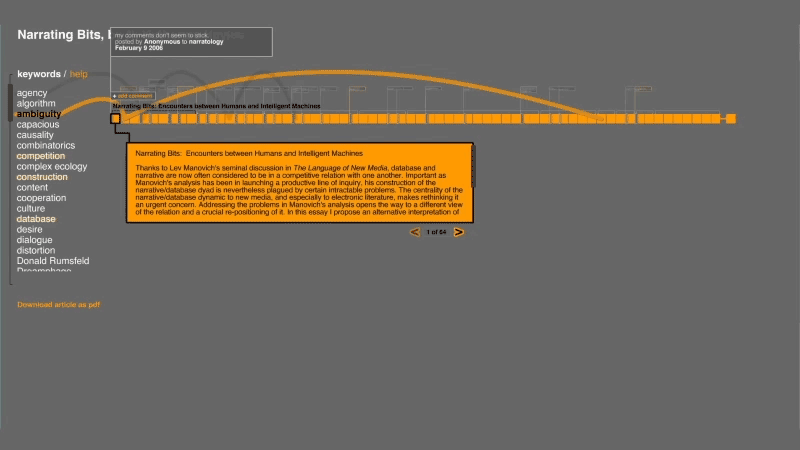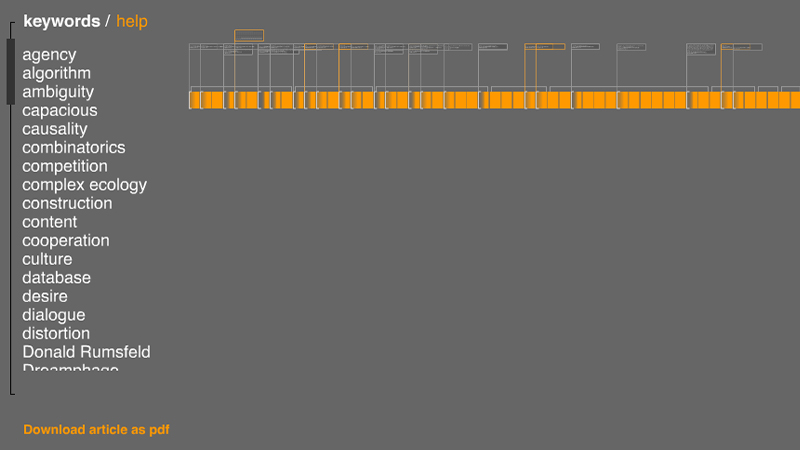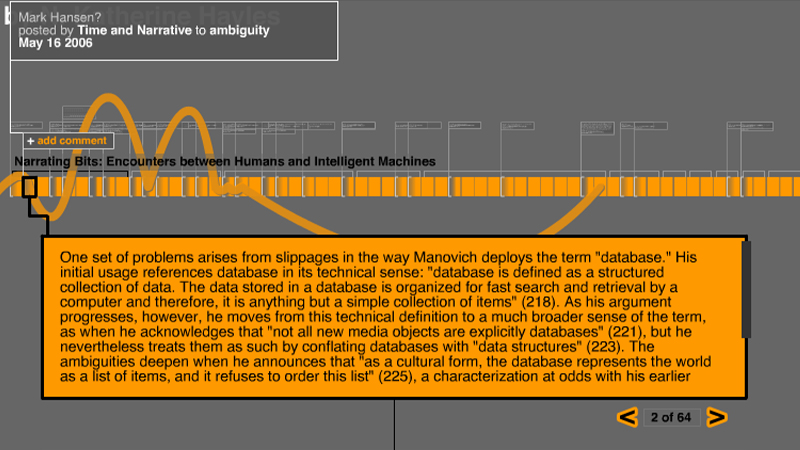Editor's Introduction
"What happens when criticism becomes a space of possibility, inviting accident, play, and mutability? Can we imagine critical scholarly argument let loose from the tight constraints of linearity, of the watchful eye of a single greedy author intent on shaping meaning? What happens to argument when new media criticism is enacted in new media? [The work] models one answer to these questions, repositioning the work of N. Katherine Hayles along new visual and interactive registers. At one level, the piece preserves the linearity of Hayles' argument, a careful parsing of the relationship of database to narrative and of the principle tenets of narrative theory. Hayles insists that the potentialities of dynamic media demand a decoupling of the narrative/database dyad, urging instead a consideration of narrative via the emergent potentialities of the 'possibility space.' The user-reader of Narrating Bits can follow this argument along a horizontal trajectory, 'clicking' through the text.
Yet, at another level, the piece visualizes text, creating a series of lexia that can be explored via multiple access points and exploring the possibility for juxtaposition, interactivity, and collision. Here, text (or blocks of text) emerge in new relationships to one another, allowing an exploration of Hayles' argument along varied trajectories. Importantly, the piece also builds in a plea for interaction, creating a possibility space of dialogue and conversation as it strains toward a vision of scholarship that models digital media's capacity for (at least the illusion of) connected presence across space and in time.
Evidence takes on many meanings in such a space. Hayles offers up a rigorous scholarly argument, complete with the evidence required to back up her claims. She also opens up the possibility for counter-evidence and for evidence of scholarly dialogue and community. Thus, Narrating Bits invites us to think about different ways we might experience evidence and its relationship to argument, providing evidence of a tantalizing new modes of academic endeavor." – Tara McPherson and Steve Anderson, Vectors Editors
Author's Statement
"One
of the frontiers of contemporary cultural and literary studies is
mulitmedia criticism -- that is, not criticism of multimedia works but
rather criticism that itself uses the resources of multimedia to
construct arguments, present evidence, and enact conclusions. This is
still a very new field, and a period of experimentation is both
necessary and inevitable. For Narrating Bits, I was delighted to
work with Erik Loyer and the Stamen team, particularly Eric Rodenbeck,
to conceptualize a design that would perform concepts crucial to the
argument, especially the notion of a 'possibility space' as a
combinatorics that precedes both the storyworld and narration. While
Erik Loyer, in collaboration with Stamen, spearheaded the production of
the piece, we worked together on ideas that would let the experience
become an interactive work of multimedia criticism.
An important
part of the design concept was the creation of a dataspace where users
can add their own comments and adaptations of my concepts as represented
by keywords. In a sense, these activities represent the way that normal
scholarly discourse operates, except that in print publication, the
statements, modifications and counter-statements take place over months
and years, while the digital medium shrinks the time scale to hours or
days. The difference amounts to a qualitative, not merely a
quantitative, transformation. It makes scholarly discourse more like a
conversation than an series of unpredictable and infrequent forays.
When writing an article for a print journal, I am often painfully aware
that my essay will appear years after I compose it, and that even more
time will pass before someone responds (if anyone ever does), by which
time I probably will have either forgotten or lost interest in the
matter under discussion. Rather than lobbing ideas over a very high
wall that I cannot see over and then waiting for months and years to see
if whoever lurks on the other side is going to respond with a missile
of her own, I now feel that I can actually play with others who may want to engage the topic.
I applaud the editors of Vectors, as well as Erik Loyer and the Stamen team, for this bold and visionary initiative. Even failures (if there are any such) become successes in this context, for they contribute to our growing understanding of how we can use multimedia criticism to create the scholarship of the present and the future. -- N. Katherine Hayles" -- from Vectors, Volume 1, Issue 1, Fall 2005
Designer's Statement
"To
design a videogame based on licensed intellectual property is a
high-profile but often unenviable task. While most of us are free to
construct our own vague topography of the storyworld implied by a
particular IP, unencumbered by any strict need for rigor, the individual
in this position must do so with machine-readable precision and in full
public view. The resulting work is expected to embody the spirit of
the license while simultaneously expanding it beyond the original
conception of the author and translating it into a completely different
medium than the one for which it was originally created. It's not
surprising that many of these projects fail on multiple counts.
I
bring up this point because it strikes me as the site where the
arguments Hayles makes here about the interaction between fabula,
sjuzhet, narrative and database are currently being lived most publicly.
The designer of a licensed videogame is constantly making decisions
about which aspects of the storyworld to incarnate as static content,
and which as combinatorics, while remaining constantly accountable to an
increasingly savvy public ravenous for any detail of program design
reported by the gaming press. The more beloved the property, the more
fierce the design advocacy from fans; endless ASCII has been spilled on
the reasons why this or that game betrays either its namesake license or
the sensibilities of hardcore gamers, and on what the game's designers
should have done instead.
We have, under much happier and more
supportive circumstances than these, undertaken to adapt Hayles' work
into a possibility space whose central narrative is not only the
article, but also the user's exploratory actions. The piece, designed
in collaboration with Eric Rodenbeck, Tomas Apodaca and Michal Migurski
of the Stamen design studio in San Francisco, is built on the foundation
of a database that allows us to tag each paragraph of Hayles' text
thematically with keywords. These keywords can then be browsed for the
trajectories they carve through the text, and the thread of a particular
keyword traced to reveal a skeletal narrative that can be embellished
with the comments of users. Our aim is an instantiation of a 'collaborative complex ecology' between narrative and database of the
type Hayles describes, and a forum where the fluidity of dialogue she
seeks can be explored. Many thanks to Kate for her enthusiasm and
willingness to open the text up in this way. -- Erik Loyer" -- from Vectors, Volume 1, Issue 1, Fall 2005
Erik Loyer
"Erik Loyer's interactive artworks have been exhibited online and in festivals and museums throughout the United States and abroad, including the Museum of Contemporary Art, Los Angeles; the Prix Ars Electronica; and Transmediale. Loyer is the creator of The Lair of the Marrow Monkey, one of the first websites to be added to the permanent collection of a major art museum, and Chroma, an award-winning web serial about the racial politics of virtual reality. As Creative Director for Vectors, he has designed numerous multimedia essays in collaboration with leading humanities scholars. Loyer's commercial portfolio includes Clio and One Show Gold Award-winning work for Vodafone as well as projects for BMW and Sony. He is the recipient of a Rockefeller Film/Video/Multimedia Fellowship, and his works have been honored in the Montreal International Festival of New Cinema and New Media and the California Design Biennial. Loyer has a B.A. in Cinema/Television Production from the University of Southern California." -- from Vectors, Volume 1, Issue 1, Fall 2005
1 COPY IN THE NEXT
Published in Fall, 2005 by Vectors in Volume 1, Issue 1.
Note: this Flash work incorporates a database and preservation work is ongoing to make it function as intended. In the meantime, we have made the work available as a playthrough. This copy was given to the Electronic Literature Lab by Erik Loyer in November of 2021.
PUBLICATION TYPE
Online Journal
COPY MEDIA FORMAT
Web


